Exploring the Depths of the 18 Puranas: A Comprehensive Overview
The 18 Puranas serve as vital texts in Indian culture, intertwining mythology, history, and philosophy. This blog delves into each of the Puranas, exploring their unique attributes and contributions to the broader tapestry of knowledge in ancient Indian literature.
Table of Contents
- Introduction to the Puranas
- Shiva Purana: Origins and Embryology
- Bhagavat Purana: The End of the Mahabharata
- Narada Purana: Structure of Varna Dharma
- Maranda Purana: Detailed Accounts of Varna Dharma
- Agni Purana: Temple Architecture and Administration
- Bhavisha Purana: Prophecies and Future Events
- Gura Purana: Knowledge and Punishments
- Kurma Purana: Ishwara Gita and Philosophy
- Matsya Purana: Lineages and Governance
- Brahmanda Purana: Cosmic and Spiritual Insights
- Conclusion: Legacy of the Puranas
- FAQs about the Puranas
Introduction to the Puranas
The Puranas are ancient texts that hold a significant place in Indian culture and spirituality. They are not merely historical accounts; they encapsulate a wide array of stories, myths, and teachings that reflect the values and philosophies of the time. The Puranas serve as a bridge connecting the spiritual and the mundane, offering insights into the nature of the universe and human existence.
Understanding the Concept of Puranas
The term “Puranas” comes from the Sanskrit word “Puranam,” which means “ancient” or “old.” Each Purana is a compilation that includes narratives about the creation of the universe, genealogies of gods, heroes, and sages, as well as cosmology and mythology. They are designed to convey moral and philosophical lessons through engaging storytelling.
Each Purana is unique in its focus and style, often employing a dialectical approach, where characters engage in discussions, making complex ideas more accessible. This storytelling tradition is crucial for the transmission of knowledge, allowing generations to connect with their cultural heritage.
Differentiating History from Mythology
Understanding the distinction between history and mythology is essential when studying the Puranas. History is typically seen as a factual account of past events, while mythology encompasses narratives that may blend fact with fiction, offering deeper spiritual or moral truths.
The Puranas, while documenting historical events, also weave in mythological elements that provide context and meaning. This interplay allows readers to explore not only what happened but also why it matters, enriching their understanding of the human experience.
The 18 Puranas: An Overview
There are 18 major Puranas, each with its own themes and teachings. They are classified into three categories based on their focus: the Sattva Puranas (which emphasize creation and preservation), the Rajas Puranas (which focus on activity and passion), and the Tamas Puranas (which deal with dissolution and chaos).
- Brahma Purana
- Padma Purana
- Vishnu Purana
- Shiva Purana
- Bhagavata Purana
- Garuda Purana
- Bhavishya Purana
- Kurma Purana
- Brahmanda Purana
- Linga Purana
- Skanda Purana
- Agni Purana
- Matsya Purana
- Vamana Purana
- Varaha Purana
- Pradama Purana
- Vishnu Dharma Shastra
Brahma Purana: The Creation and Time
The Brahma Purana provides a detailed account of the creation of the universe and the concept of time in a cyclical manner. It describes the sequence of “manvantaras,” vast epochs that span millions of years, and the events that transpire within them.
This Purana also explores the concept of yoga, establishing principles that are still relevant in contemporary practice. It emphasizes the importance of understanding the cosmos and our place within it, offering insights into the nature of existence.
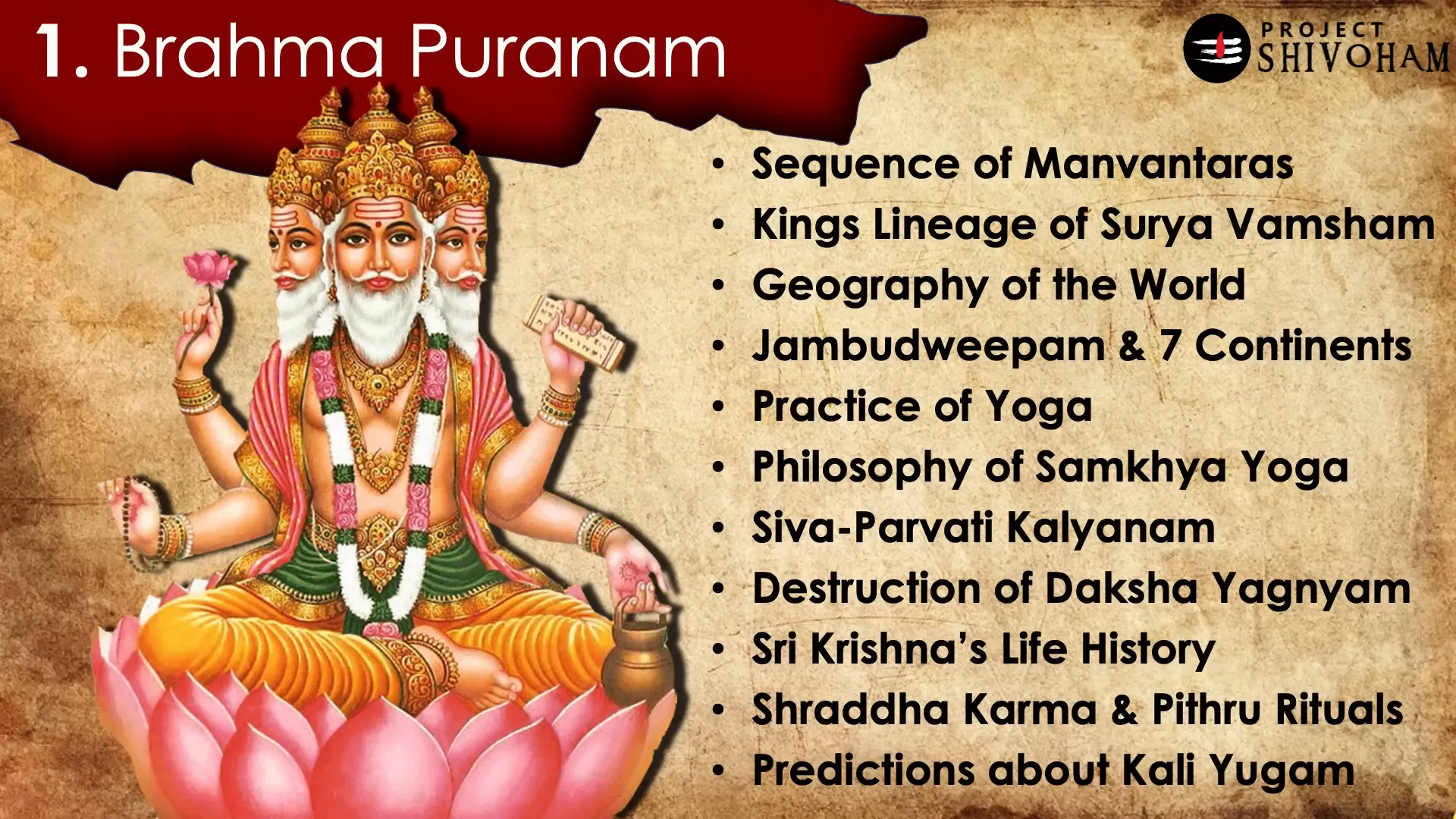
Padma Purana: The Birth of Lakshmi
The Padma Purana is notable for its rich narratives around the goddess Lakshmi and her significance in Hindu worship. It elaborates on her birth and the various aspects of her divine nature.
This Purana also delves into the tales of the Ramayana, providing additional context and details that are not found in the original texts. It serves as a complementary narrative that enriches the understanding of these epic stories.
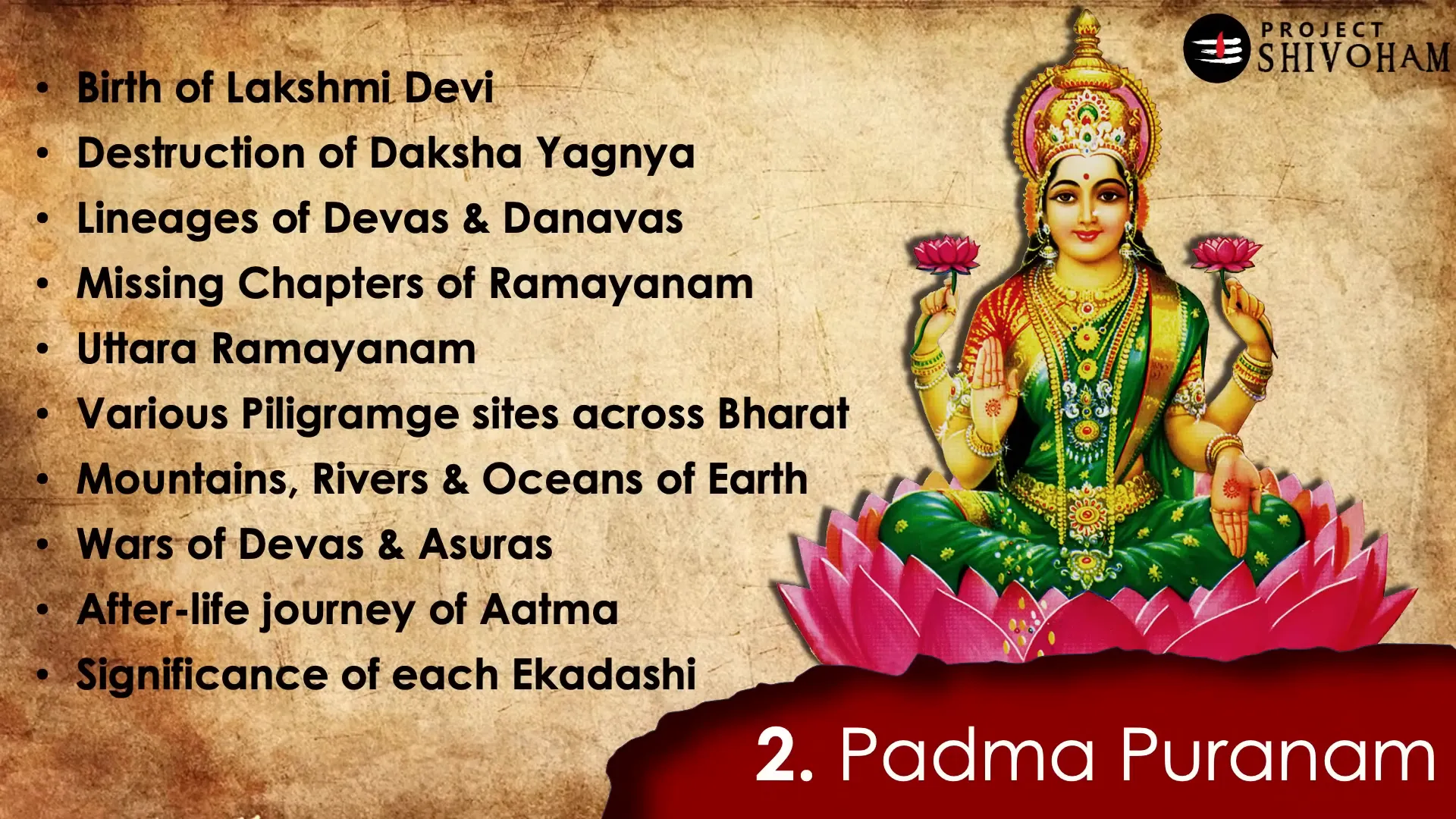
Vishnu Purana: Time Division and Measurement
The Vishnu Purana stands out for its detailed examination of time, introducing various units of measurement that range from the minute to the cosmic scale. It discusses the cyclical nature of time, encapsulated in the concepts of “kalpas” and “mahayugas.”
This Purana also outlines the lineage of kings and the structure of the Vedas, providing a framework for understanding the historical context of these texts. It emphasizes the importance of rituals and the worship of deities, particularly Vishnu.
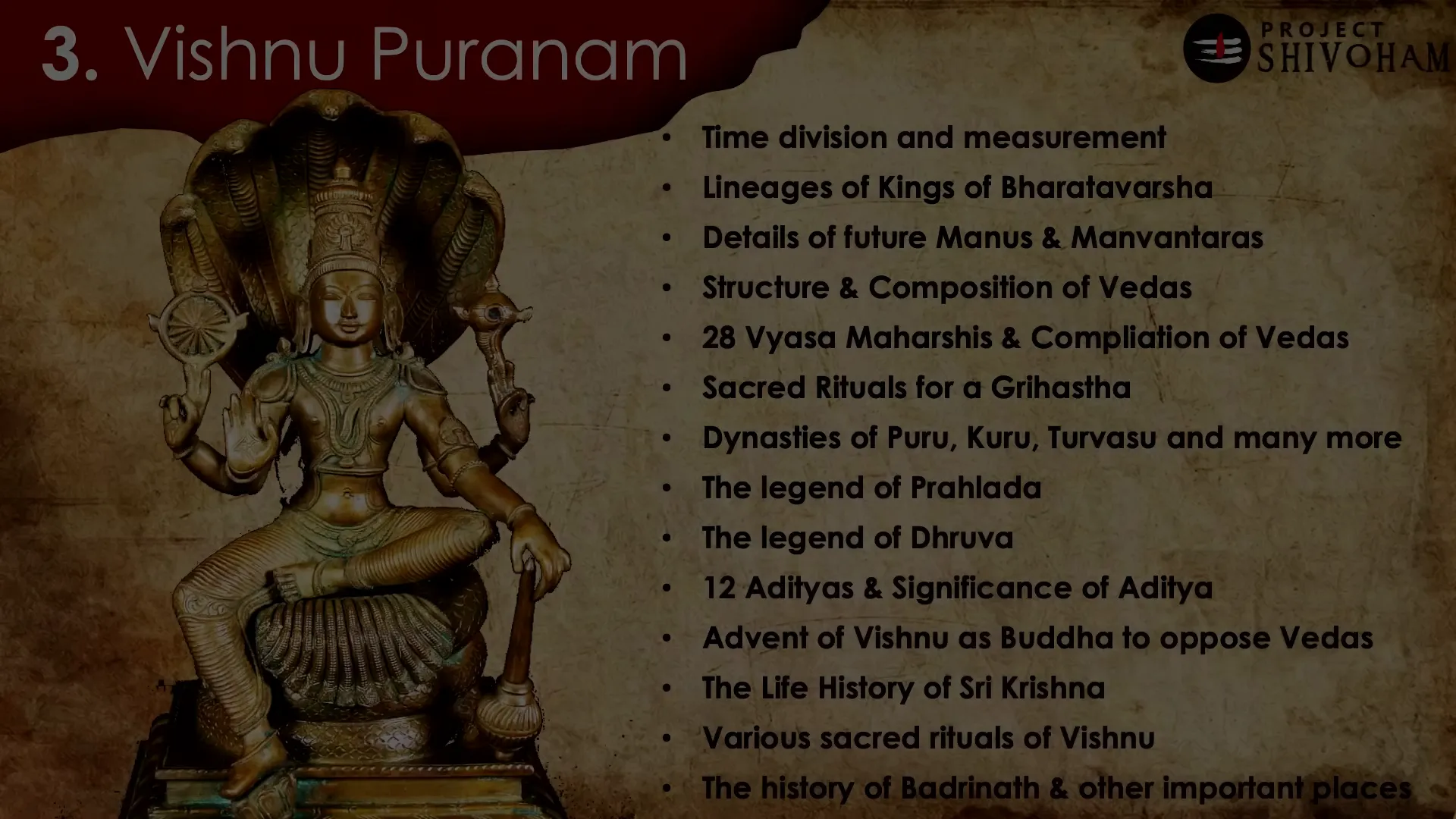
Shiva Purana: Origins and Embryology
The Shiva Purana is a profound text that delves into the origins of Lord Shiva and the philosophical underpinnings of his worship. It begins by illustrating the cosmic conflict between Sri Mahavishnu and Brahma, setting the stage for the significance of Shiva in the Hindu pantheon.
One of the key themes of the Shiva Purana is the sacred rituals associated with the Shivalingam, which symbolizes the formless aspect of Shiva. The text elaborates on the philosophy of Shiva, known as Shiva Tatwam, which encompasses the principles of creation, preservation, and dissolution.
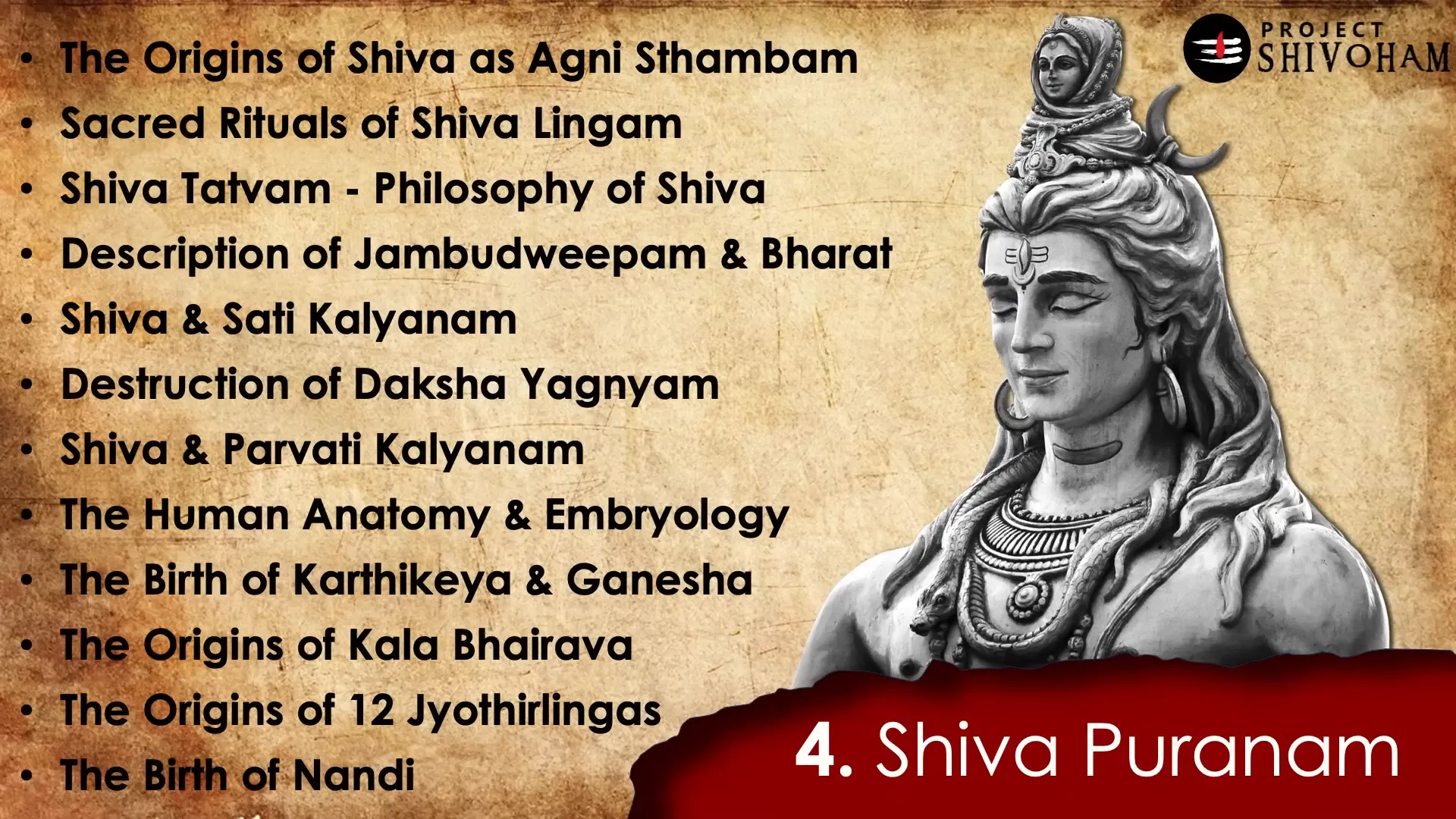
Furthermore, the Shiva Purana provides intricate descriptions of geographical locations, particularly Jambu Dham, which is pivotal in Hindu cosmology. It also discusses the significant events in Shiva’s life, such as the destruction of Daksha’s Yagna and the union of Shiva and Parvati.
Another remarkable aspect of this Purana is its detailed account of human anatomy and embryology. It elaborates on the stages of fetal development in the womb, offering a comprehensive biological perspective that intertwines spirituality with science.
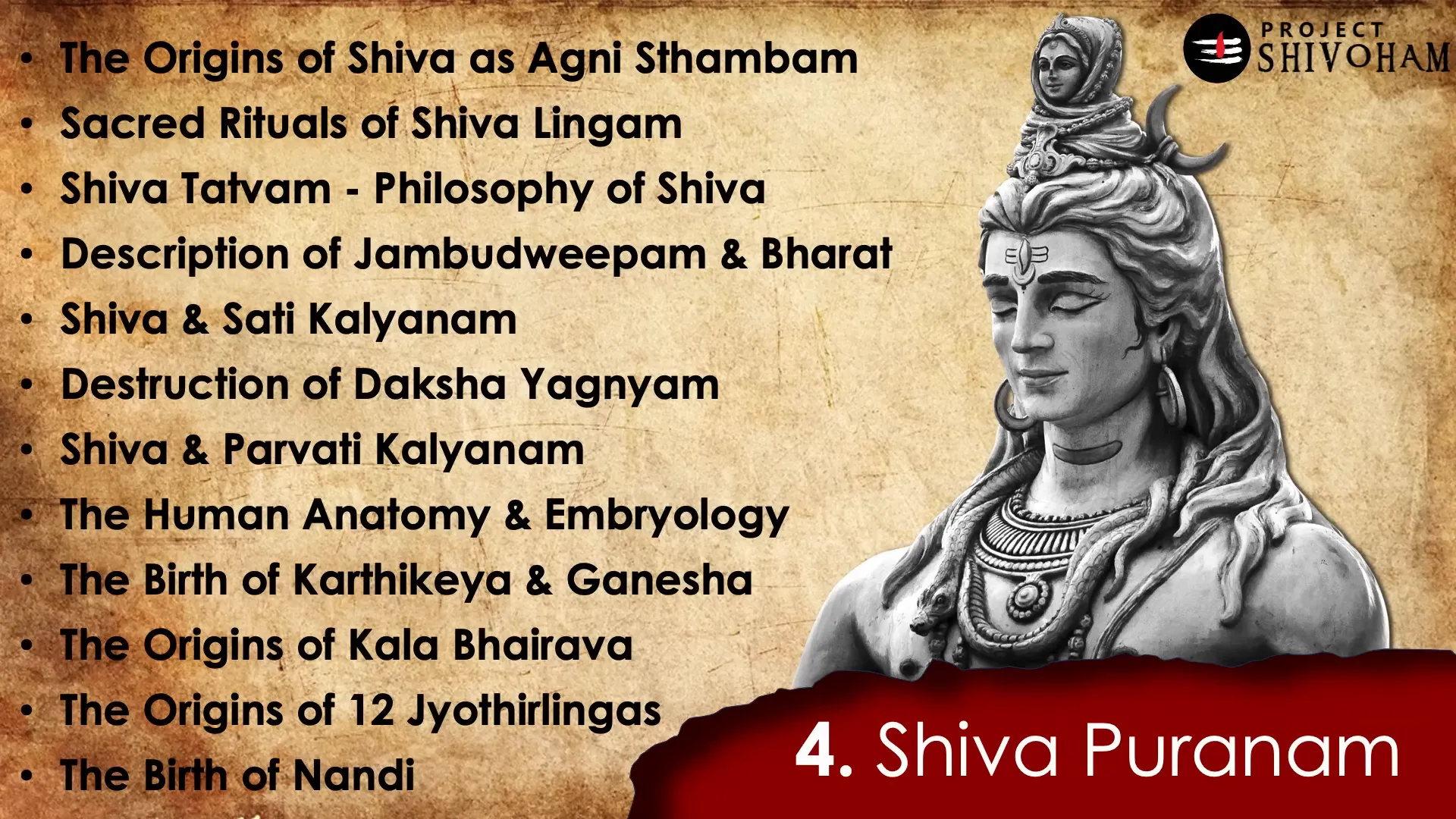
Additionally, the Purana recounts the births of notable deities like Kartikeya and Ganesha, emphasizing their roles within the Hindu tradition. The origins of the twelve Jyotirlingas and the birth of Nandishwara are also explored, showcasing the rich tapestry of narratives that define the Shiva Purana.
Bhagavat Purana: The End of the Mahabharata
The Bhagavat Purana, also known as the Shrimad Bhagavatam, serves as a continuation of the Mahabharata, providing insights into the events that unfold after the epic’s conclusion. It narrates the story of Maharaja Parikshit, the last descendant of the Pandavas, and his encounters with various sages.
One of the significant themes in the Bhagavat Purana is the start of the Kali Yuga, the age of darkness and conflict. It discusses the moral decline of society and the emergence of different philosophies that arise in response to these challenges.
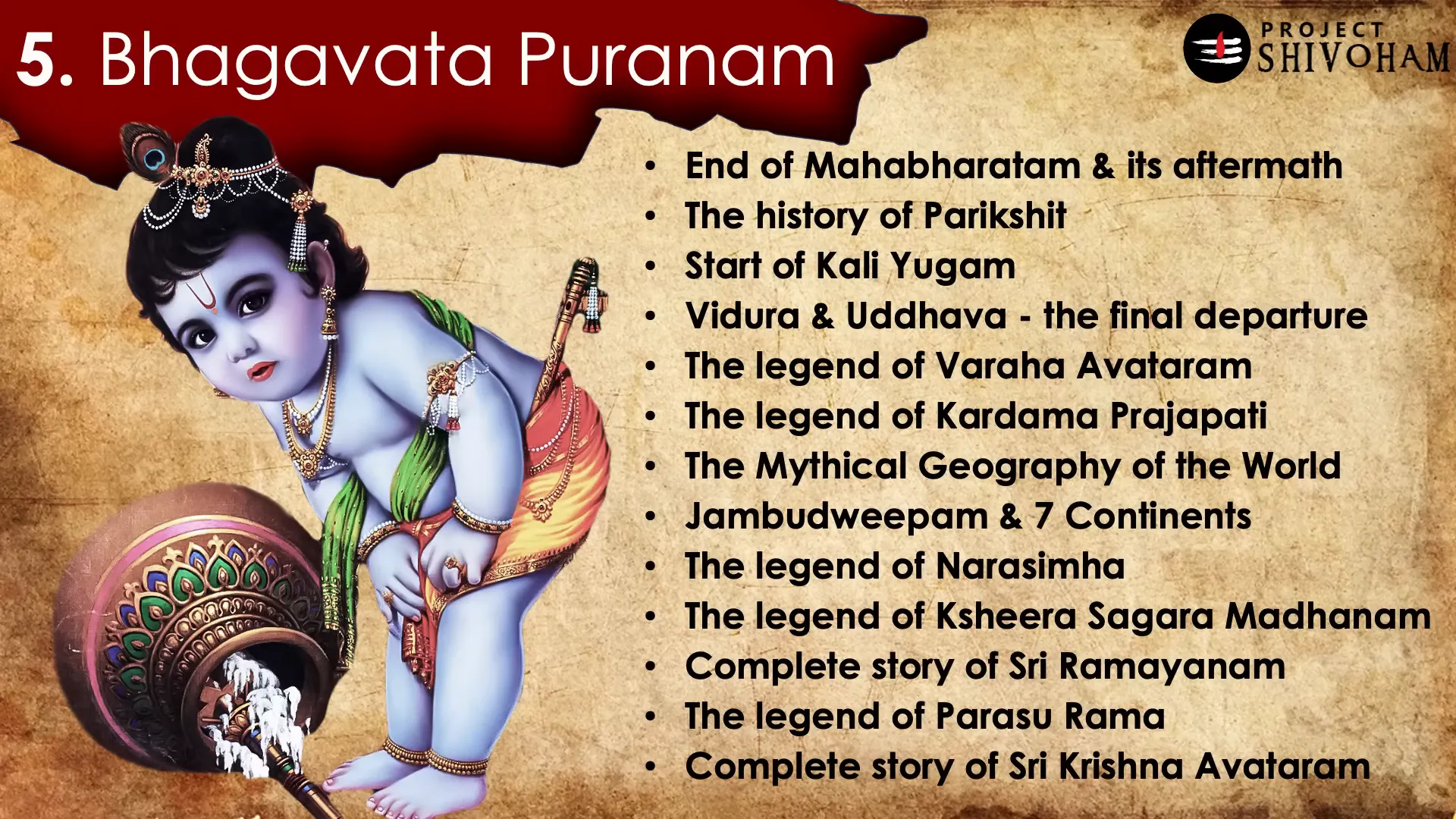
Moreover, the text elaborates on the legendary conversations between Uddhava and Vidura, which are rich in philosophical discourse. These dialogues impart wisdom on the nature of reality and the importance of devotion to God.
The Bhagavat Purana also recounts the legends of Narasimha, the man-lion avatar of Vishnu, and the churning of the ocean, known as Samudra Manthan, which yielded various divine treasures. The complete story of Sri Ramayana, the life history of Lord Krishna, and the significance of the Vedas are also elaborated within its verses.
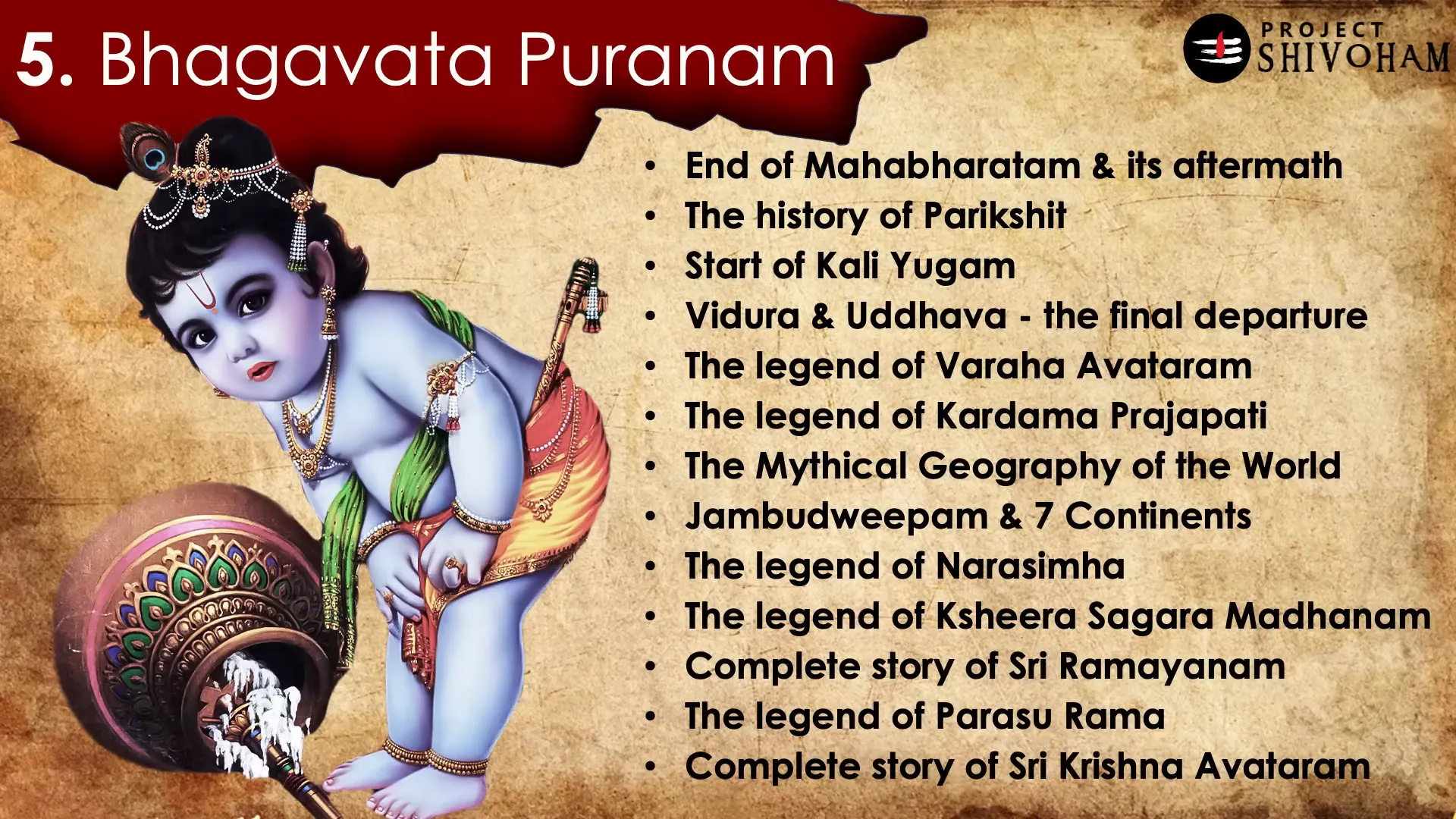
Narada Purana: Structure of Varna Dharma
The Narada Purana focuses on the structure and duties inherent in Varna Dharma, a socio-economic governance system that existed in ancient India. This text is crucial for understanding the roles and responsibilities associated with each Varna, or caste, and how they contributed to societal harmony.
Instead of relying on contemporary interpretations, the Narada Purana provides an authentic perspective on how Varna Dharma was structured, offering insights into its historical context. It emphasizes that Varna Dharma serves as a framework for ethical living and social order.
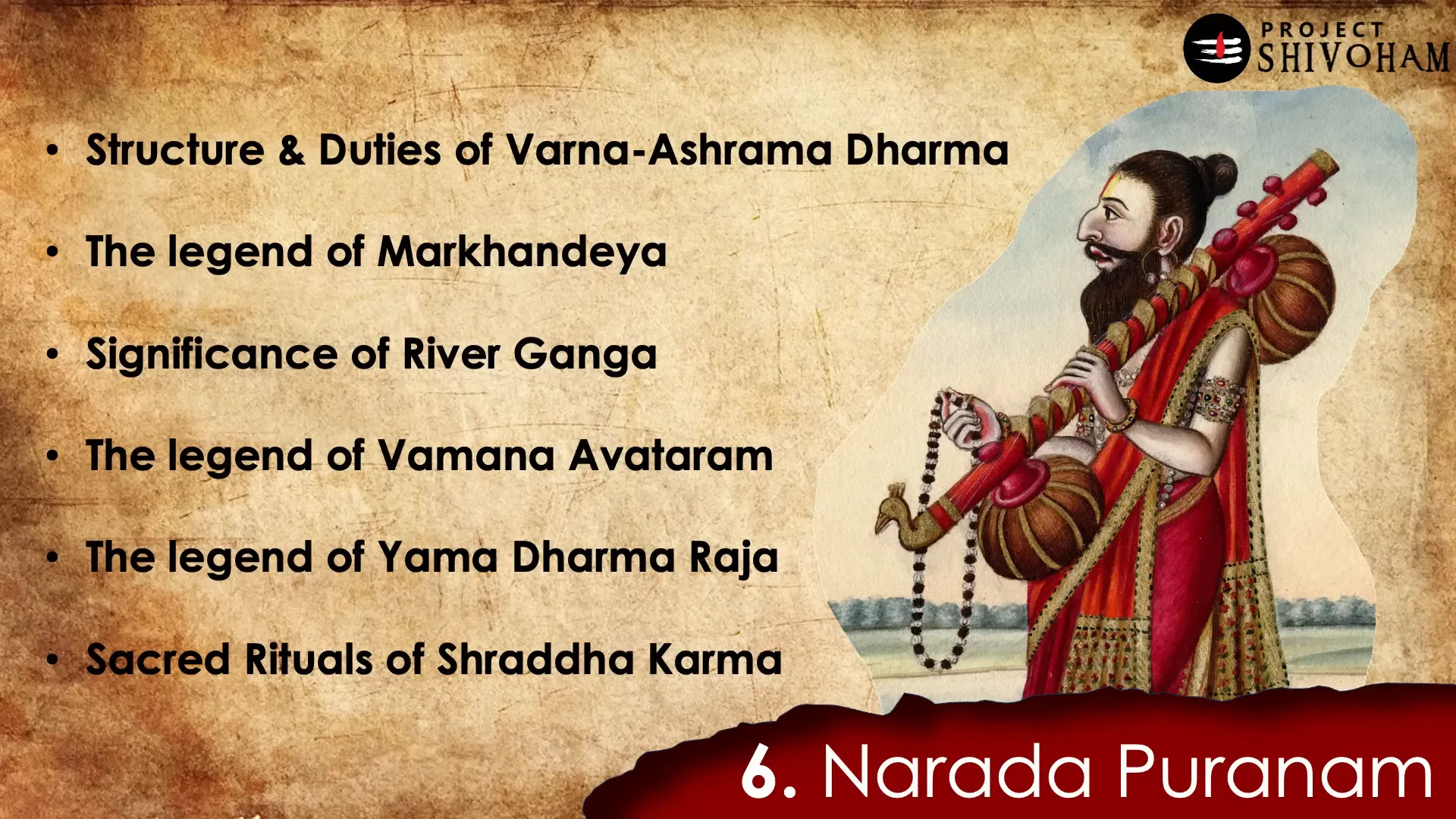
Additionally, the Narada Purana narrates the significance of the Ganges River and its role in spiritual cleansing. It also covers the legends of various avatars and the rituals associated with honoring ancestors, known as Pitru Deva.
Through its teachings, the Narada Purana encourages readers to engage with these ancient texts to understand the complexities of human relationships and societal structures.
Maranda Purana: Detailed Accounts of Varna Dharma
The Maranda Purana stands out as one of the most comprehensive texts on Varna Dharma, surpassing even the Narada Purana in detail. It comprises thousands of shlokas dedicated to elaborating on the principles of Varna Dharma, marriage forms, and the intricacies of human relationships.
This Purana emphasizes the importance of nurturing relationships and provides guidelines on dietary practices for different ashramas, or life stages. It addresses misconceptions about non-vegetarian food, illustrating that dietary choices can vary based on one’s Varna and context.

Furthermore, the Maranda Purana elaborates on the worship of Adishakti, the divine feminine energy, and discusses the philosophies of yoga. It warns against the dangers of misapplying yoga practices, underscoring the necessity of proper guidance in spiritual pursuits.
Ultimately, the Maranda Purana illustrates the life of a typical yogi, providing a holistic view of spirituality and ethics in ancient Indian society.
Agni Purana: Temple Architecture and Administration
The Agni Purana offers a wealth of knowledge on temple architecture and the engineering principles behind sacred structures. It details the various styles of temple construction and the rituals involved in consecrating deities within these temples.
This Purana also delves into the administrative aspects of running a temple, including the responsibilities of priests and the management of temple resources. It emphasizes the significance of maintaining the sanctity of religious practices and the importance of community involvement in temple activities.
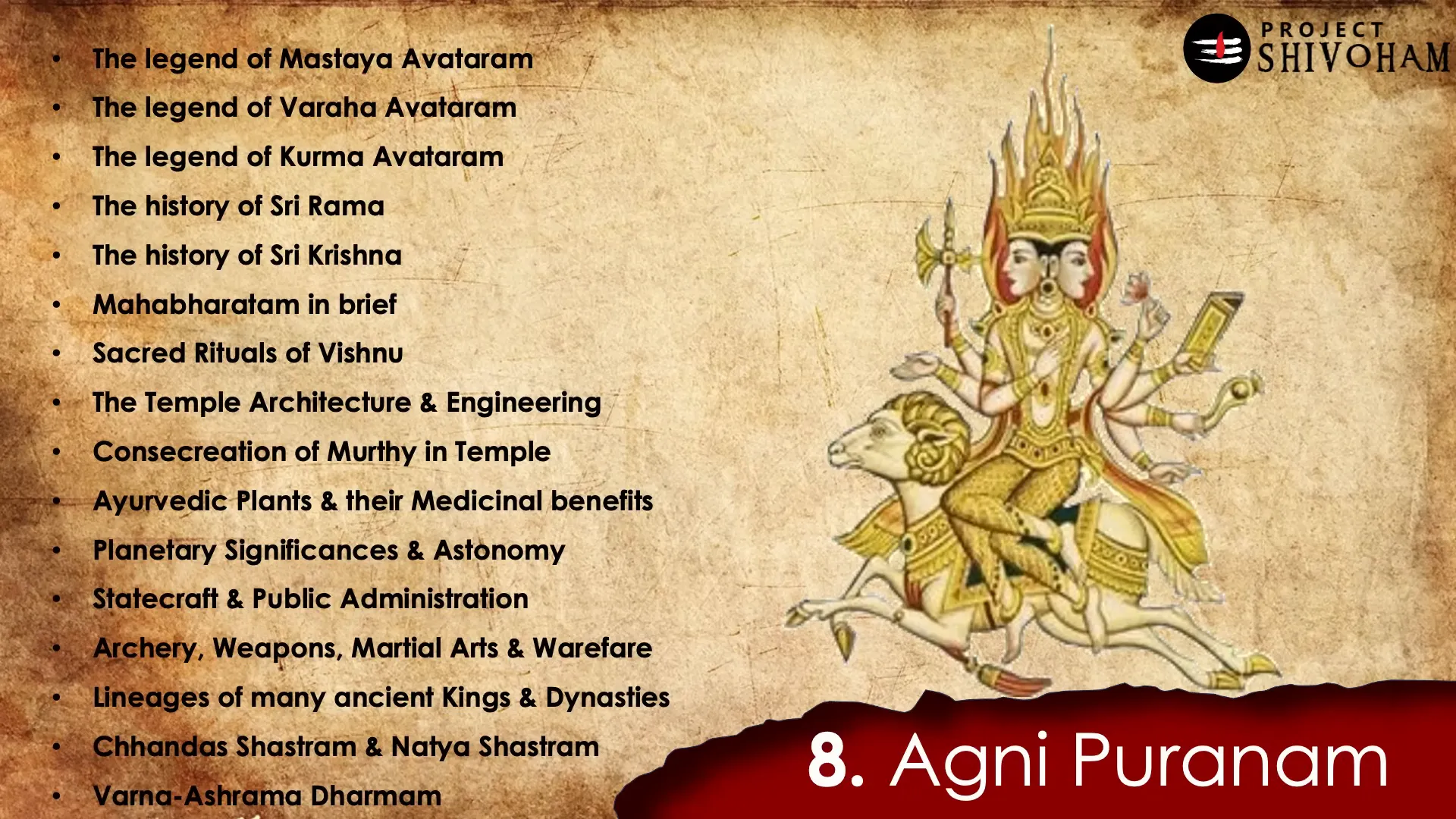
Moreover, the Agni Purana provides insights into the medicinal benefits of various plants, highlighting the intersection of spirituality and healing practices. It discusses the role of astrology in temple administration and the importance of aligning temple activities with celestial events.
Additionally, the Agni Purana covers martial arts, strategies of warfare, and the historical lineages of kings, showcasing the diverse range of topics addressed in this extensive text.
Bhavisha Purana: Prophecies and Future Events
The Bhavisha Purana is primarily centered around prophecies concerning future events and the moral decline of society. It emphasizes the importance of rituals for the departed and the significance of honoring ancestors.
This Purana foretells the emergence of malevolent cults in the Kali Yuga, which will lead to destruction and suffering across the world. It also discusses the cyclical nature of time and the inevitable changes that societies undergo.

Furthermore, the Bhavisha Purana provides detailed accounts of future kings and dynasties, emphasizing the role of divine grace in shaping history. It serves as a reminder of the consequences of moral neglect and the importance of adhering to dharma.
Gura Purana: Knowledge and Punishments
The Gura Purana is a fascinating text that addresses a range of topics, including the formulation of antidotes for various poisons. It is rich in knowledge, detailing remedies and practices for healing different ailments.
This Purana also discusses the architecture of temples and provides insights into gemology, including methods for testing the purity of precious stones. It emphasizes the importance of ethical living and the pursuit of knowledge as pathways to spiritual growth.
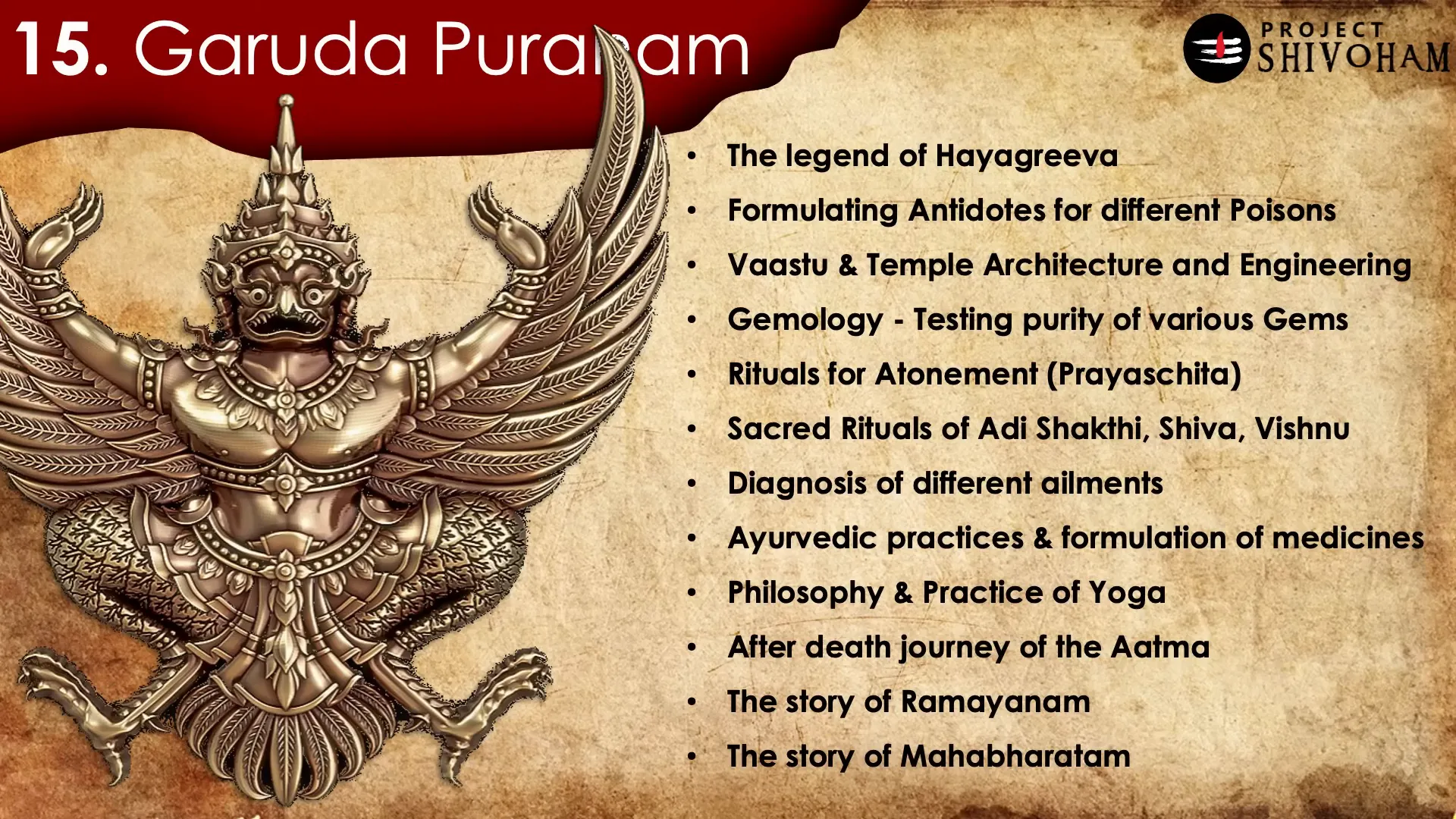
Additionally, the Gura Purana elaborates on the philosophy of yoga and Ayurvedic practices, offering guidelines for maintaining health and well-being. It also includes a section on the consequences of one’s actions, detailing the various punishments that await the soul based on past karma.
Through its teachings, the Gura Purana presents a holistic view of life, intertwining spirituality with practical knowledge, and encourages readers to engage deeply with the principles outlined within its verses.
Kurma Purana: Ishwara Gita and Philosophy
The Kurma Purana is a treasure trove of philosophical insights, prominently featuring the Ishwara Gita. This text serves as a compendium of life lessons imparted by Mahadev, guiding individuals on their spiritual journey.
Within the Kurma Purana, the concept of time is elaborated, providing a framework for understanding its divisions and computations. It delves into various legends, including the significance of Vatar Parvati Sahastra and the tales of Shiva Ganas. Furthermore, it documents the rich conversations between Krishna and Shiva, showcasing the interconnectedness of divine figures in Hindu mythology.
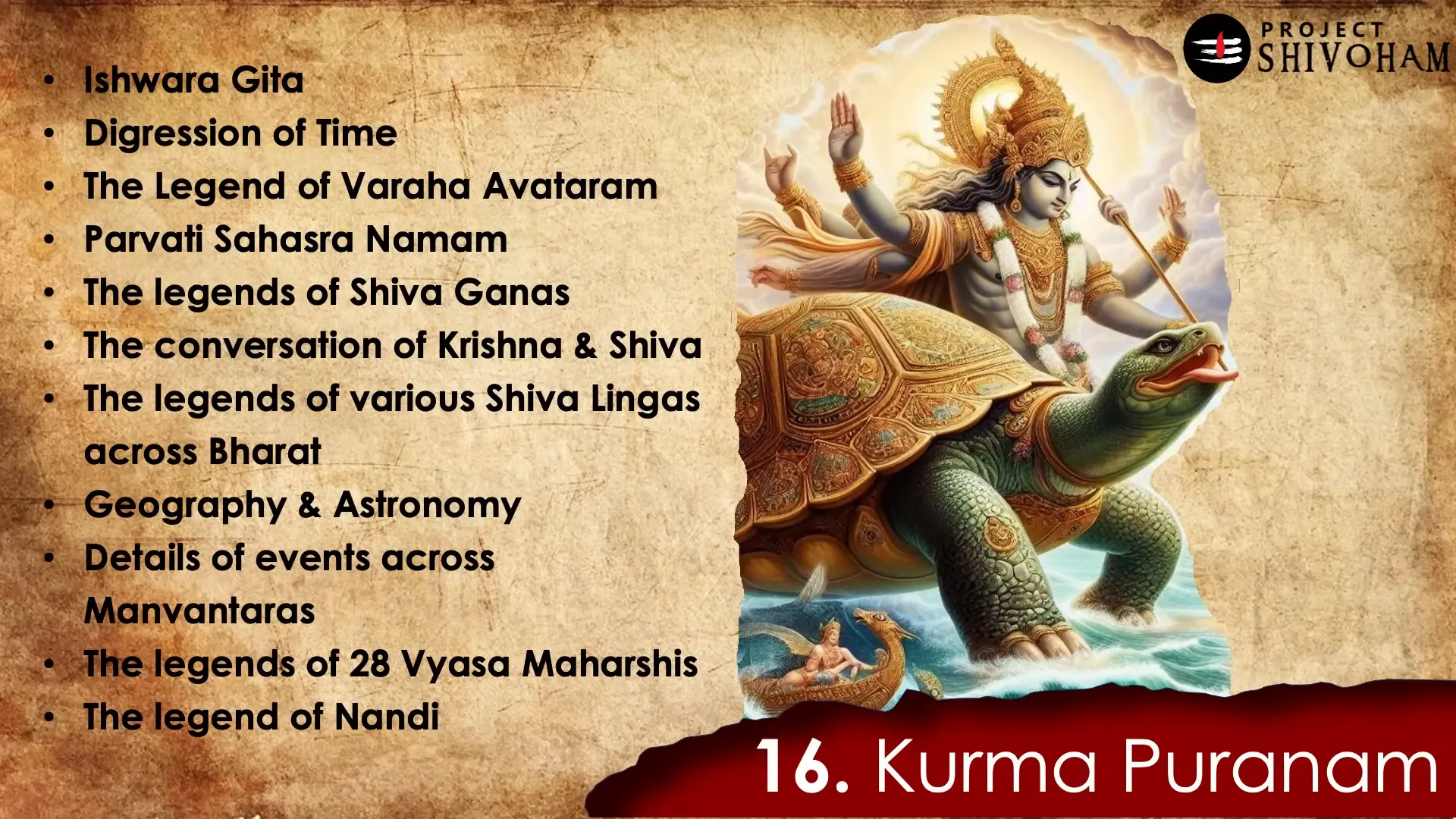
The geographical and astronomical details presented in the Kurma Purana enhance the narrative, illustrating the events across different Manvantaras. It also highlights the 28 Vasa Maharis, detailing their contributions and works, thereby emphasizing their vital role in the spiritual lineage.
Additionally, the legend of Nishara is explored, further enriching the tapestry of stories that define this Purana. The Kurma Purana thus encapsulates a holistic view of philosophy, mythology, and spirituality.
Matsya Purana: Lineages and Governance
The Matsya Purana stands out for its meticulous documentation of lineages, tracing the heritage of notable dynasties such as the Sura, Chandra, Yadava, and Kosala. This linear format of inheritance provides a clear understanding of who came from whom, preserving the continuity of bloodlines.
Beyond genealogies, the Matsya Purana discusses sacred rituals associated with the worship of deities like Vishnu, Shiva, and Adishakti. It serves as a guide for statecraft and public administration, outlining how a king should treat his subjects and govern effectively.
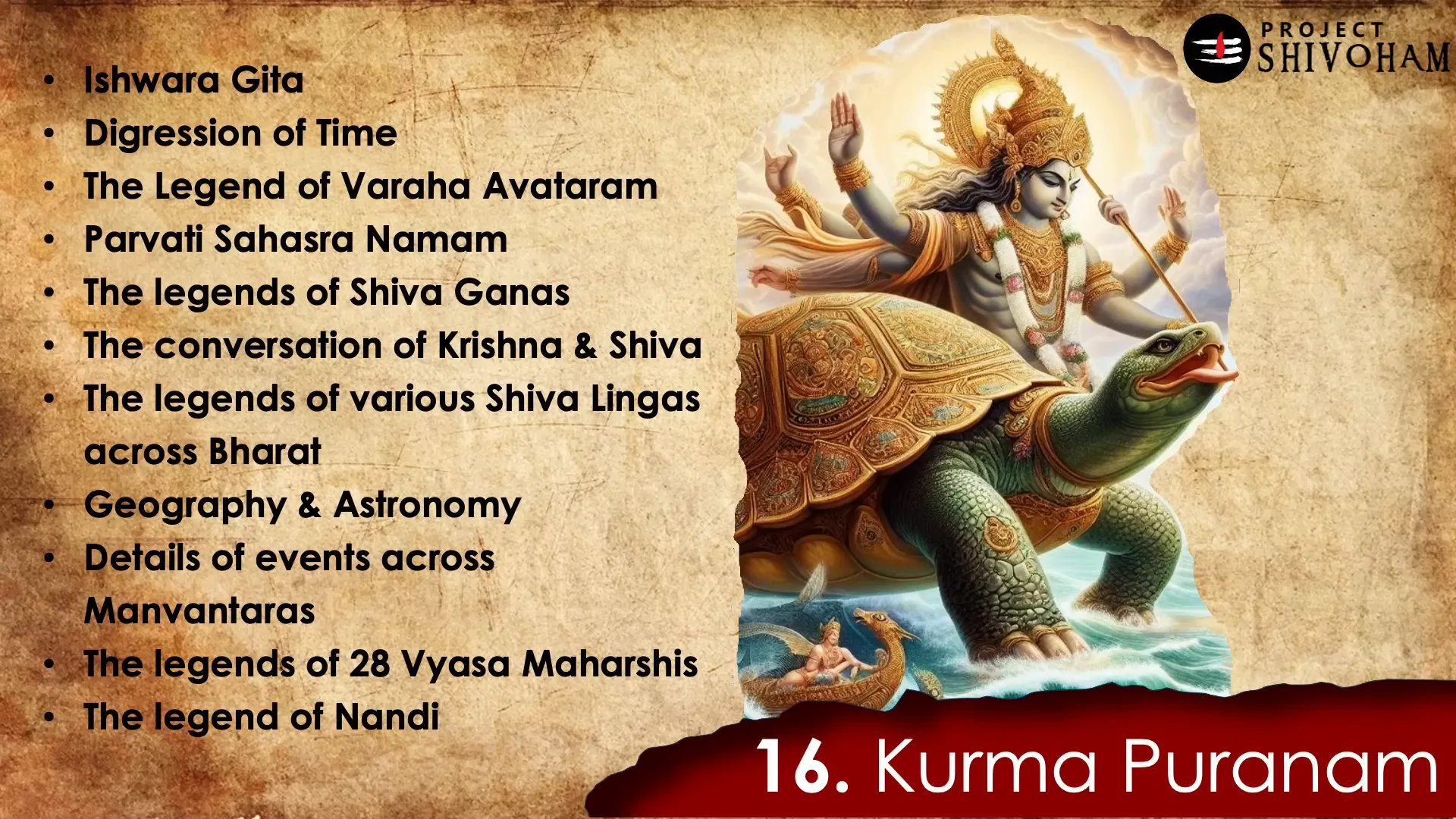
Moreover, the Purana delves into the architecture and engineering of temples and forts, offering insights into the ancient world’s geographical landscape. The teachings within the Matsya Purana provide invaluable knowledge for understanding governance, societal roles, and the spiritual responsibilities of leadership.
Brahmanda Purana: Cosmic and Spiritual Insights
The Brahmanda Purana is a profound text that encompasses a wide array of cosmic and spiritual insights. It discusses various time divisions, including Kalpas and Manvantaras, which are essential for understanding the cyclical nature of the universe.
This Purana elaborates on the genesis of creation, detailing the geography of the world and Bharat. It narrates the legends of the Saptarishis, the seven celestial sages, and explores their individual stories, contributing to the rich spiritual heritage of Hinduism.

Additionally, the Brahmanda Purana enumerates pilgrimage sites across Bharat, emphasizing the importance of sacred rituals dedicated to the ancestors, known as Pitas. The legends of Parashurama, Manu, and the River Ganga are intricately woven into the narrative, highlighting their significance in the spiritual landscape.
One of the remarkable aspects of the Brahmanda Purana is its scientific elucidation of sound, explaining how the pitch and frequency of musical notes can evoke specific emotional responses. This blend of spirituality and science showcases the depth of knowledge contained within this ancient text.
Conclusion: Legacy of the Puranas
The Puranas, as a collective body of work, represent a legacy that transcends time. They are not merely historical texts; they embody the philosophies, sciences, and artistic expressions of ancient India.
Each Purana contributes to a broader understanding of the cosmos, human existence, and divine principles. As we explore these texts, we uncover layers of wisdom that continue to resonate with contemporary audiences, urging us to reflect on our own lives and the world around us.
The teachings of the Puranas encourage a balanced approach to knowledge, urging us to appreciate the intricate connections between spirituality, ethics, and governance. They remind us that ancient wisdom holds relevance even in today’s fast-paced world.
FAQs about the Puranas
What are the Puranas?
The Puranas are a genre of ancient Indian literature that encompasses mythology, history, and philosophy. They serve as sacred texts that convey moral and spiritual teachings through storytelling.
How many Puranas are there?
There are 18 major Puranas, each with its own themes, narratives, and teachings, categorized into three groups based on their focus: Sattva, Rajas, and Tamas.
What is the significance of the Kurma Purana?
The Kurma Purana holds philosophical insights and elaborates on the Ishwara Gita, explaining the nature of time, divine legends, and spiritual teachings that guide individuals on their path.
What does the Matsya Purana focus on?
The Matsya Purana primarily focuses on genealogies of various dynasties, sacred rituals, governance principles, and the architecture of temples and forts, providing a comprehensive view of ancient Indian society.
How does the Brahmanda Purana contribute to our understanding of the universe?
The Brahmanda Purana offers insights into the cosmic order, the cycles of creation, and the significance of pilgrimage sites, while also integrating scientific concepts related to sound and its emotional impacts.
Courtesy: Aravind Markandeya @project shivoham